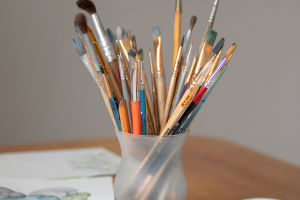When we look at someone, we notice more than their features—we notice their energy. In portrait art, our goal isn't just to draw a face accurately. It's to capture what makes that person them.
Their calm, strength, humor, or mystery. But how do we express that on paper or canvas? Let's dive into how we can bring out a subject's unique personality in portrait art.
Start with observation, not assumptions
Before we even begin sketching, we need to slow down and really see the person. What's their posture like? How do they carry themselves? Is their gaze direct or soft? Observing these subtle details helps us go beyond physical traits and notice emotional tones. Every person gives off a different vibe—and that's where real portrait art begins.
Choose a meaningful pose
A pose tells a story. A person looking down may seem reflective. A chin raised may suggest confidence or even pride. Hands folded can feel composed, while a slight lean forward might hint at curiosity or openness. We shouldn't just ask someone to "sit still." Instead, we can explore what pose feels most them, and build our artwork from that.
Let the eyes lead the mood
Eyes are often called "windows to the soul," and for good reason. Whether sharp and focused or soft and dreamy, the eyes reveal emotion. In our portrait, let's give extra attention to their shape, light reflection, and angle. Even a tiny spark in the eye can change the whole mood of the piece. They're small, but they carry so much.
Work with expressive lighting
Lighting can shape the atmosphere of our entire portrait. Soft side lighting can bring warmth and calm. Dramatic shadows can add mystery or seriousness. Backlighting adds glow and elegance. Let's ask: what type of light fits this person's energy? We can use lighting as a storytelling tool—not just to show features, but to reflect emotion.
Use color with intention
Color choices go far beyond skin tone. Cool blues and purples can express peace or sadness. Warm reds and oranges bring energy and passion. Muted tones might suggest quiet strength or maturity. Let's not be afraid to use bold or unexpected colors if they help tell the story of the subject's personality.
Capture texture and character
Wrinkles, freckles, hair texture, or scars—they all add character. Instead of trying to "perfect" someone's face, we can embrace these features. They tell stories of experience, age, joy, or hardship. We don't need to exaggerate them, but including these textures adds honesty and life to the portrait.
Tell a silent story
A strong portrait often feels like it's saying something, even without words. We can add subtle clues—maybe the subject is holding something important, like a book, a camera, or a tool they use every day. Maybe there's a meaningful background, or a specific outfit that reflects their identity. These details help us tell a deeper story without saying a thing.
Make room for emotion
Sometimes we get caught up in technical accuracy and forget the feeling. Let's remind ourselves: what do we want others to feel when they see this portrait? Calm? Wonder? Nostalgia? We can loosen our strokes, soften certain edges, or add texture in specific areas to guide that emotion.
Practice with real people
The best way to grow is by drawing or painting people we know. Friends, family, or even strangers with interesting expressions. When we know someone, it's easier to tune into their essence—and learn how to express it visually. It also helps us experiment with different styles, from realistic to stylized, and see what best fits our voice.
Whose story will you tell next?
So Lykkers, next time you sit down to create a portrait, try asking yourself: What makes this person truly unique? Go beyond the lines and shadows. Think about the story, the feeling, and the energy. That's where the real art lives.
Have you created a portrait you feel proud of—or one that challenged you? We'd love to hear about your experience. Let's keep learning how to see people, not just with our eyes, but with our hearts.


